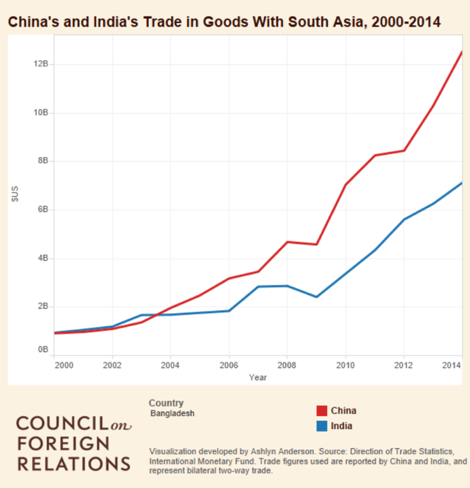Balancing India and China: The Impact of Foreign Relations on Bangladesh
Primary Analyst: Amily Li
This article will focus on Bangladesh’s economic relations with its two most important partners, India and China. India has been an important neighbour since Bangladesh’s independence and China is a rising economic and diplomatic ally. The developing relationship between Bangladesh and China has the potential to increase tensions with India, negatively affecting trade and regional peace that will threaten the growth of Bangladesh’s textile industry. Thus, mitigation strategies focusing on emphasizing peaceful relations through economic cooperation are recommended to maintain geopolitical stability.
Bangladesh-India Relations
Bangladesh’s most important relationship is with India. This relationship is culturally, historically, and economically intertwined due to geographic proximity. The character of this relationship depends heavily on the governing party and leaders of Bangladesh. Warmer ties with India are exhibited when the Awami League (AL) is the ruling body in government, while tension heightens when the Bangladesh Nationalist Party (BNP) is in power due to its anti-India stance. Fortunately, Bangladesh’s current government has been led by Prime Minister Shiekh Hasina Wajed and AL since 2008, improving the tone of bilateral relations with India. However, despite general government compatibility and India’s military contributions to Bangladesh’s struggle for independence in the 1970s, tensions still exist between the neighbours. Some of the most significant tensions are border disputes along Bangladesh’s eastern perimeter, disagreements over river water sharing, continued illegal migration of Bangladeshis into India, and the presence of anti-Indian militia bases in Bangladesh.
India is Bangladesh’s second largest import trading partner accounting for 14% (US$5.51B) of total imports. In comparison, Bangladeshi exports to India amounts to 1.7% (US$622M) of total exports. The majority of Indian imports include essential food items, mostly notably rice, a staple to Bangladeshi diet. Should this flow of goods be interrupted due to political tensions, this will have negative impact on the livelihood of the entire nation.
Bangladesh-China Relations
Within the past decade, Bangladesh’s government has been building closer ties with China. The Chinese government has invested significantly in the development of Bangladesh’s military capacity and infrastructure, committing US$24B in the latter. For instance, the Bangladesh-China Defense Cooperation Agreement signed in 2005 highlighted China’s commitment to help Bangladesh harness its nuclear energy.
In regard to the trade sector, development of the Sino-Bangla economic relationship is crucial for the continued growth of the Bangladesh’s textile industry. China is Bangladesh’s largest trade partner, with Chinese imports accounting to 36% of Bangladesh’s total imports, notably, 35% of Chinese imports include raw materials needed for Bangladesh’s textile industry, namely cotton, fabrics, threads, yarn and other apparel accessories. In return, 80% of Bangladeshi exports to China consist of readymade garments (RMG). Consequently, maintaining this bilateral relationship is necessary for the success of Bangladesh’s textile industry. Since China’s cheap raw materials permit Bangladesh to produce RMGs at low cost, this will allow Bangladesh to maintain a competitive trade surplus in textile thus continuing to attract clothing companies in Europe and the United States, which collectively account for roughly 80% of Bangladesh’s textile market.
Industry Risk and Mitigation Strategies
Bangladesh’s growing diplomatic ties with China may indirectly threaten India and harm the Bangladesh-India relationship. Since both China and Bangladesh are amid ongoing border disputes with India (with the Indo-Chinese circumstance significantly more contentious in nature), Bangladesh’s move towards closer militaristic and diplomatic ties to China may alarm India and exacerbate existing tensions. Furthermore, China overtook India as Bangladesh’s largest trading partner in 2005, challenging India’s dominance in South Asia, as seen on the graph below.

Foreign relations with China are imperative to Bangladesh’s textile industry. However, should India find reason to be threatened over tightening Bangladesh-Chinese cooperation, especially in the military realm, the possibility of military invasion anywhere along the 4000km Bangladesh-India border cannot be ignored. This development would exacerbate political instability in Bangladesh and cause chaos in all areas of domestic affairs, including the textile industry.
As a result, solutions must be formulated to mitigate such risks. Encouraging the expansion of trade relations with India will foster peace and reduce tension among the three nations. More specifically, India is concerned over China’s increasing influence in South Asia, one that has potential to replace India as the region’s traditional dominant power. To offset China’s growing economic leverage at the expense of India, foreign actors should stress to the Bangladeshi government the importance of maintaining a balanced relationship between China and India in its foreign affairs. Furthermore, the government should continue to enhance the economic and defense relationships among its South Asian neighbours in order to preserve regional exclusivity that will reassure India of Bangladesh’s commitment to regional peace.

